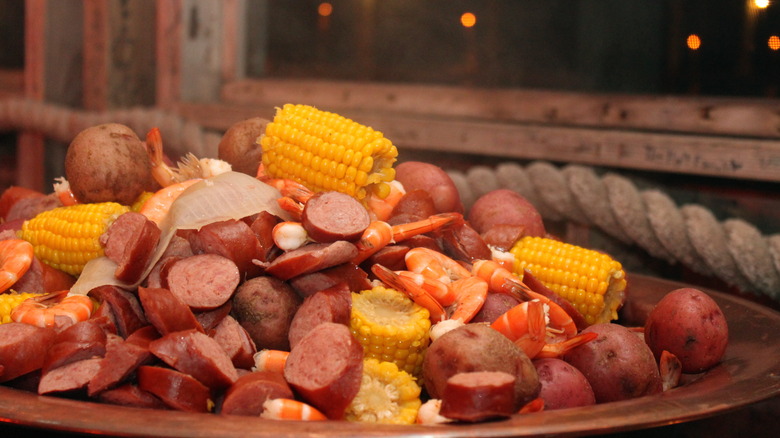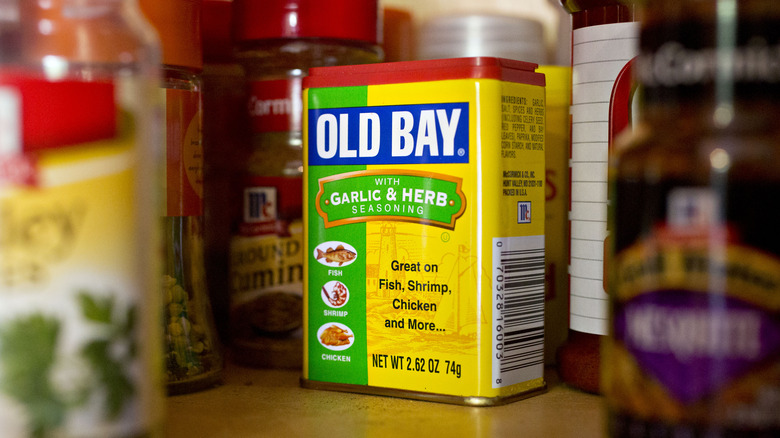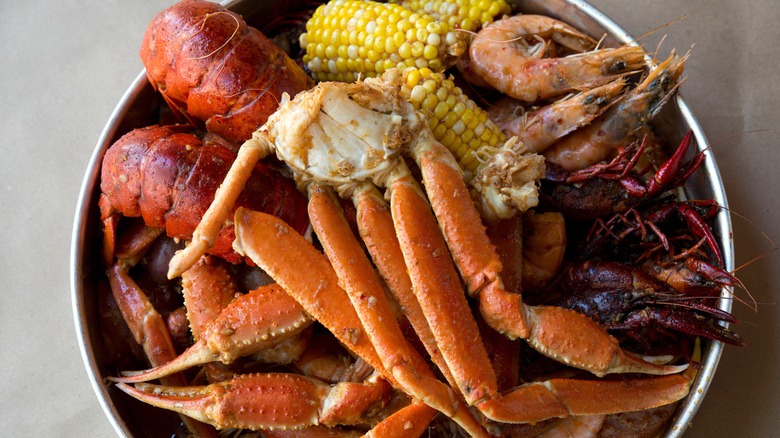The Hearty Ingredients You Need For Lowcountry Boil
The coastal Lowcountry region of America incorporates the two states of South Carolina and Georgia (though sometimes North Carolina and Florida are considered if talking about the historic Gullah Geechee area). Hosting the Atlantic Ocean as well as countless marshlands, estuaries, creeks, bayous, and rivers, the Lowcountry gives rise to distinctly water-centric communities. Seafood is a given in this mysterious and deeply historic part of the country — where eclectic recipes bear influence from African heritage, former slave plantations, and sea-swarthy European traders, all dictated by resilience and readily available marine life.
One of the most beloved dishes emerging from this area is the aptly named Lowcountry boil. The riotous mix of steaming-hot ingredients gets boiled together in a huge pot and ceremoniously plopped in the center of a communal table, traditionally one clad in newspaper. It's definitely a seafood-centric meal, but other specific ingredients help create the hearty one-pot magic. The Lowcountry version of a seafood boil most often includes shrimp, boiled new potatoes, cobbed corn, smokey kielbasa or andouille sausage, and sometimes onions or beer. Many recipes these days also include crab legs and occasionally crawfish.
The spices are equally crucial to the mix, and you can buy them pre-mixed or create your own version that's customized per your preference.
Spicing up a filling Lowcountry boil
To get the classic taste of a Lowcountry boil, the spice varieties are pretty much universal and synchronized. That's why professional and home-kitchen chefs alike routinely use pre-made spice mixtures such as Old Bay seasoning, available throughout the country now. The iconic stubby, square cans feature wide holes for generous sprinkling –– or more like heavy dashing if doing it the genuine Lowcountry way. It's also fairly common, depending on where you live, to find boil-in-bag spice mixtures made specifically for shrimp and crab boils.
Homemade spice mixtures take more time to assemble, but the process gives chefs more control over the concentrations of each ingredient, particularly allowing for spicier or tamer taste explosions. The mix routinely includes richly aromatic flavor-punchers like bay leaves, cardamom, paprika, dill, cayenne pepper, celery salt, mustard seeds, allspice, and more. Overall, this is not a mild-flavored meal, but it doesn't have to be fiery –– just distinctively well-seasoned. A few lemon wedges, garlic bulbs, and whole peppercorns join the steaming pot, rounding out the classic taste of a Lowcountry boil.
Remember to serve with cocktail sauce, tartar sauce, and even hot sauce for those who crave the kick. Seafood, corn, sausage, potatoes, and spices blend together perfectly for a hearty, comforting meal.
How Lowcountry boil ingredients compare to other Deep South versions
The taste of a Lowcountry boil is largely consistent throughout South Carolina and Georgia, but it does go by some different names. One of the earliest known seafood boils in the region is called Frogmore Stew, which still serves as a culinary blueprint for authenticity. It comes from the small Frogmore community in South Carolina's Beaufort County, on the island of St. Helena. The so-called "stew" was featured in "Gourmet Magazine" as far back as the 1980s. Other names include Beaufort boil or stew, Georgia boil, Tidewater boil, and a Carolina One-Pot.
Though a Lowcountry boil indicates the regional preferences of its cradling states, the dish is essentially still a seafood boil, similar to other versions in America. As such, it's perfectly fine to add other types of shellfish in the mix, depending on what's available in nearby waters. For example, a Louisiana-style Cajun or Creole boil is more likely to feature crab or crawfish along with the shrimp, and sometimes even mussels.
The sausage can vary as well. In Louisiana boils, it's almost always andouille, which is also favored in their iconic gumbos and jambalayas. While a traditional Lowcountry boil sometimes uses andouille, it's equally as likely to have kielbasa sausage resting amongst all that tasty boiled seafood. Whether it's Lowcountry, Louisiana, Cajun, or other Deep South boils, they all have similar deep roots, formed over generations by community rituals and a common reverence for nature's aquatic sustenance.



